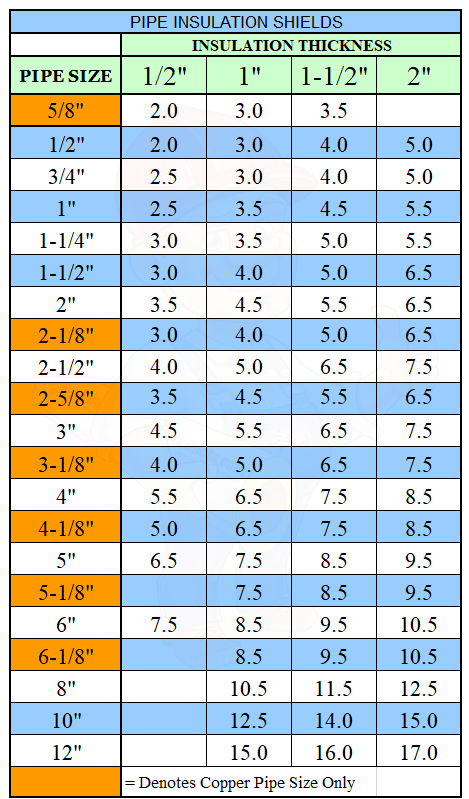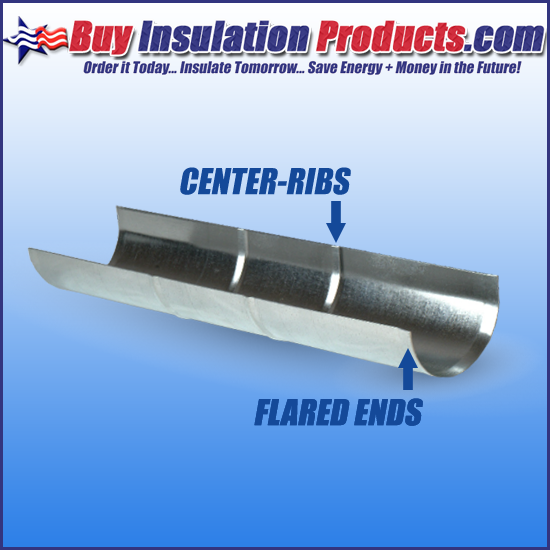When do we need to use Pipe Insulation Shields?
Posted by BIP on 23rd Apr 2024
When do we need to use Pipe Insulation Shields?
Pipe Insulation Shields are used as protection for pipe insulation at all pipe support points. These support points are where the piping is held up on horizontal piping systems. The support points may include clevis hangers, strut channel bars, pipe straps, etc. At these support points, the weight of the pipe system is being held up and without proper protection the pipe insulation will be compressed and the insulation value and vapor barriers will be compromised.
What is a Pipe Insulation Shield?
Pipe Insulation Shields are 12" long galvanized sheet metal that is pressed into a curved segment sized to pop onto the lower half of a piece of pipe insulation. Our pipe insulation shields are pressed with 2 center ribs which increase the strength of the shield while allowing the shield to sit centered on the pipe support. If a clevis hanger, strut channel, or strap is placed in-between the shield's ribs, the shield will stay securely in place without slipping off through seismic motion. Our pipe insulation shields also feature flared ends, which prevents the jacketing of the pipe insulation from tearing when sliding the shield into place or with seismic motion back and forth over time. The flared end keeps the edge of the metal shield from touching the jacket.
Can a Pipe Insulation Shield be Installed by Itself?
On certain pipe insulation materials, a pipe shield may be installed without any other insulation support. These types of insulations are extremely rigid and have the compressive strength to bear the weight of the pipe system. For fiberglass pipe insulation and rubber pipe insulation which we sell on our site, both require an additional pipe support to be installed prior to the pipe insulation shield. These pipe supports provide the pipe insulation the compressive strength to support the weight of the piping at the support points. These pipe insulation supports include Fiberglass H-Blocks and Insulation Wooden Support Pegs.
Ordering the Correct Pipe Insulation Shield Size:
If you are familiar with the insulation sizing charts on our site, the Pipe Insulation Shield Size Chart is setup the same way. On the chart posted below, select your Pipe Size on the left most column. If you are using copper piping make sure to convert to the correct IPS - Iron Pipe Size: Click here for Copper to Iron Size Conversion. Once you have selected your pipe size row, move over to the insulation wall thickness column that you are installed or have installed. (1/2" thick to 2" thick). Please contact us on wall thicknesses greater than 2" or if you need help with choosing the correct size. You can then order that shield size in the corresponding cell. For example if you have 2" iron pipe and are installing 1" thickness of insulation, you would order shield size: 4.5. Please note that the shield sizes may be rounded to the nearest half inch and may not represent the true diameter of the shield. For example a 3.0 shield is actually 2-7/8" in diameter.

How to Install Pipe Insulation Shields:
The installation of our pipe insulation shields is rather simple. During the insulation process, the insulator would place the shield onto the pipe support point (clevis hanger, strut channel, etc.) and then install the pipe insulation section that will be centered on the pipe support point. The pipe insulation can be either slid into place on to the pipe shield or pushed down into the pipe shield. Because our pipe insulation shields are flanged, they can be carefully slid into place if the insulation has already been installed at the support point.
Sometimes the pipe insulation shields are installed prior to the pipe insulation being installed. This is commonly found when a mechanical contractor or pipe installer is required to provide the shields. In this case the shield may be tack welded to the clevis hanger. The insulator would then later lift up the piping and slide the pipe insulation into place inside the pipe shield.


